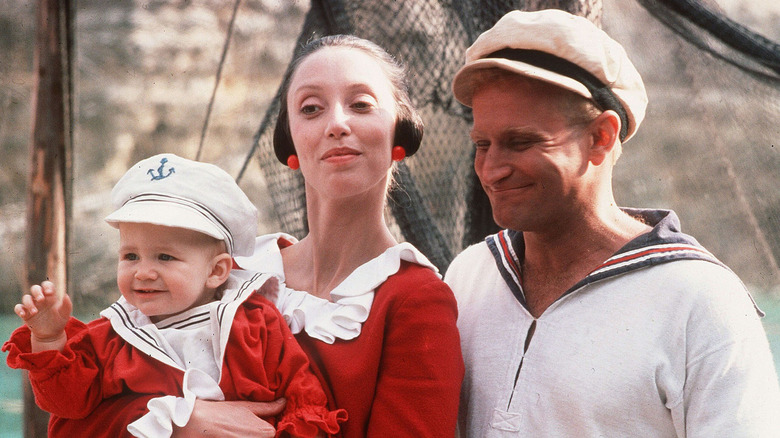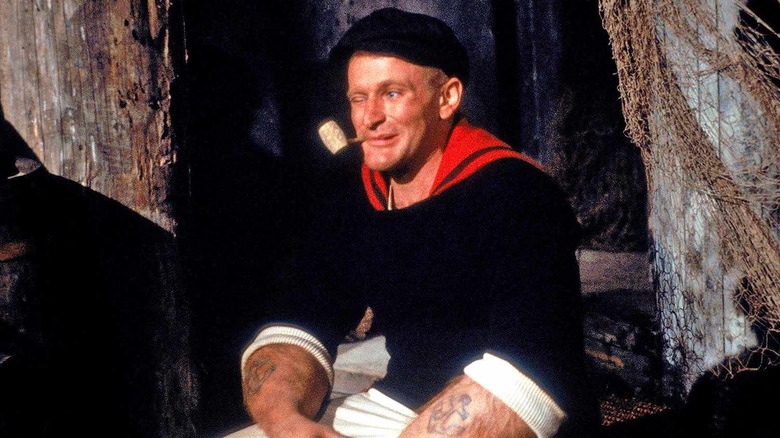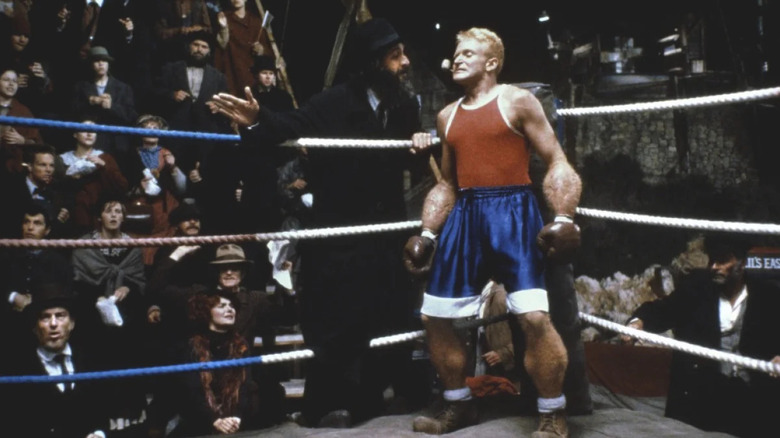Robin Williams' Live-Action Popeye Movie Was A Production Nightmare
The landscape along the road from Mellieha to the west coast of Malta is pretty sparse until you reach the sea by the old World War II pill box and look down into the bay below. There, you will be greeted with a remarkable and incongruous sight: a picturesquely ramshackle village that looks like it has sprung fully-formed from the pages of a comic book. That was, of course, the intention, as it was specially built for "Popeye," Robert Altman's notorious comedy musical based on the classic comic strips by E.C. Segar.
The Popeye Village doesn't take long to walk around, but it is a marvel of production design. Indeed, it was perhaps unnecessarily over-designed for the needs of the film. Logs were brought in from the Netherlands and wooden roof shingles were shipped all the way from Canada for the seven-month construction, which employed 165 tradespeople and required eight tons of nails and 2,000 gallons of paint. I recall wandering through the tilted streets on a family holiday to the island in the 1990s thinking, "There are real villages back in England less detailed than this." Aside from Sweethaven itself, living quarters, a music studio, and an editing suite were also built from scratch, and all that extravagance offers an indication of the excess that turned the shoot into a production nightmare.
"Popeye" wasn't even Paramount's first pick for a live-action musical based on a comic. It came about in 1977 after the studio lost out to Columbia for the rights to "Annie," resulting in producer Robert Evans turning to the indefatigable sailor instead. Three years passed before cameras rolled on the custom-built Maltese set, by which time the original casting choices of Dustin Hoffman and Gilda Radner (as Popeye and Olive Oyl, respectively) were replaced by Robin Williams and Shelley Duvall. Maverick director Robert Altman, coming off the back of a string of flops at 20th Century Fox, was drafted in as an unlikely pick to helm the film after Hal Ashby and Louis Malle both turned their noses up at the project. Yet, there was reason to be optimistic. Williams was hot after his star-making turn in "Mork & Mindy," while Duvall was the perfect choice to play Olive (as she was even nicknamed after the character as a kid). But once the cast and crew got to the island in the Mediterranean, things got very chaotic indeed.
The Popeye set was awash with cocaine
Cocaine was a big factor in Hollywood in the late 1970s and early '80s, back when movies like "The Blues Brothers" and "Caddyshack" became notorious for the large amounts of nose candy used during filming. Even Carrie Fisher admitted that she took coke on the set of "Star Wars: Episode V — The Empire Strikes Back" during that period, making "Popeye" but one of many high-profile productions fueled by tons of marching powder.
Robin Williams was already heavily into drugs and alcohol by the time he took on his first lead role in a film, which was a kind of origin story as Popeye arrives in Sweethaven looking for his long-lost dad, falls for Olive Oyl, butts heads with Bluto (Paul L. Smith), adopts a foundling baby called Swee'Pea, and discovers a taste for energy-boosting spinach. Howard Storm, Williams' director on "Mork & Mindy," described the extent of the problem (via El País): "He was snorting coke, and if you snort coke, in order to come down you drink booze. He was out all night and screwing everybody in town."
Producer Robert Evans was also partial to cocaine, and his habit almost got him into deep trouble with the Maltese authorities. He brought some supplies with him on a flight from the United States, which went awry when his baggage went missing at the airport. He was later busted for trafficking while the movie was in post-production, but the charges were subsequently dropped.
It wasn't just the movie's star and producer who indulged. Barry Diller, who was then CEO for Paramount Pictures, stated in no uncertain terms that "Popeye" was the "most coked-up film set" he had ever visited during an interview with Anderson Cooper (via Entertainment Weekly), claiming, "Everyone was stoned." Bringing cocaine onto the set apparently became part of the catering and required some ingenuity. Diller said that film cans shipped from Los Angeles to Malta on a daily basis were used to smuggle in the drug, while co-composer Van Dyke Parks recalled opening up a walkie-talkie to change the battery only to end up finding a bag of blow stashed inside. Diller went on to suggest that copious cocaine use even had an effect on the pacing of the final film, comparing it to vinyl records (via El País):
"If 33 revolutions per minute is the standard speed for playing an LP on a turntable, this is a movie that plays at 78 revolutions per minute."
Drugs weren't the only problem during the Popeye film shoot
Locations in Florida and Bogota, Colombia, were considered for "Popeye" before Malta was selected thanks to its deepwater infinity tank and a handy cove where Robert Evan's production team could build the village of Sweethaven. When the cast and crew arrived on the island nation in January 1980, one thing they probably couldn't have anticipated was rain interrupting play. Malta is a popular tourist destination partly due to its Mediterranean climate and good weather most of the year, but some of the worst rainstorms in 40 years caused the production to run two months over. Consequently, the film also ran over budget and tempers began to fray. Robert Altman's son Stephen, who worked on "Popeye" as a production designer, once described how hard it was:
"Doing 'Popeye' was like going to a war in a distant country. It was traumatic. We all had PTSD. We can tell funny stories about it now, but for many years afterwards it was like, 'Oh man, don't talk about Malta.'"
Malta certainly isn't the worst place you could get stuck for several months, but it is a long time to spend away from home in a hectic drug-fueled situation with costs spirallng, unseasonably bad weather, and no apparent plan how to finish the film. Eventually, the studio demanded that Altman wrap things up and return to Los Angeles with what he had, resulting in a rushed and rather improvised ending.
Even before "Popeye" hit theaters, overspending and the chaotic shoot led some people to label the film "Evans' Gate," referencing Michael Cimino's bloated bomb "Heaven's Gate" (which killed one of Hollywood's most iconic studios). It wasn't quite that bad — "Popeye" made a decent return at the box office, bringing in $60 million from a $20 million budget. Yet, it was still perceived as a flop due to the fact that it wasn't the massive hit that Paramount expected, and nobody actually seemed to like it. Somehow, it avoided the ignominy of receiving any nominations at the inaugural Golden Raspberry Awards, but it did take Worst Picture at the Stinkers Bad Movie Awards. The overall stench surrounding the film put Robert Altman on the Hollywood naughty step for much of the '80s, eventually causing him to leave the United States for a period of self-exile in France to rebuild his career again.


